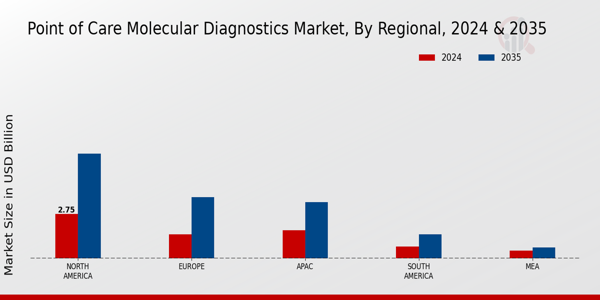Market Growth Projections
The Global Point of Care Molecular Diagnostics Market Industry is poised for substantial growth in the coming years. Projections indicate that the market will expand from 6.25 USD Billion in 2024 to 15 USD Billion by 2035, reflecting a robust CAGR of 8.28% from 2025 to 2035. This growth trajectory is influenced by various factors, including technological advancements, rising demand for rapid diagnostics, and increasing prevalence of infectious diseases. As the industry evolves, stakeholders are likely to witness significant opportunities for innovation and market expansion.
Government Initiatives and Funding
Government initiatives and funding significantly impact the Global Point of Care Molecular Diagnostics Market Industry. Various governments are investing in healthcare infrastructure and promoting the adoption of advanced diagnostic technologies. These initiatives aim to improve healthcare access and quality, particularly in underserved regions. For example, funding programs that support the development and deployment of point-of-care molecular diagnostics are likely to enhance market penetration. Such government support not only fosters innovation but also encourages collaboration between public and private sectors, ultimately driving the growth of the market.
Rising Demand for Rapid Diagnostics
The Global Point of Care Molecular Diagnostics Market Industry experiences a surge in demand for rapid diagnostic solutions. This trend is driven by the increasing need for timely and accurate results in various healthcare settings. For instance, the market is projected to reach 6.25 USD Billion in 2024, reflecting a growing preference for point-of-care testing. Healthcare providers and patients alike favor these solutions due to their ability to deliver results within minutes, thereby facilitating quicker clinical decisions. This shift towards rapid diagnostics is likely to enhance patient outcomes and streamline healthcare processes, further propelling the market's growth.
Growing Focus on Personalized Medicine
The Global Point of Care Molecular Diagnostics Market Industry is increasingly aligned with the growing focus on personalized medicine. As healthcare shifts towards tailored treatment approaches, molecular diagnostics provide critical insights into individual patient profiles. This enables healthcare providers to make informed decisions regarding treatment options, particularly in oncology and chronic disease management. The integration of point-of-care testing into personalized medicine strategies is anticipated to enhance patient care and improve therapeutic outcomes. Consequently, this trend is likely to bolster market growth, as the demand for personalized diagnostic solutions continues to rise.
Increasing Prevalence of Infectious Diseases
The Global Point of Care Molecular Diagnostics Market Industry is significantly influenced by the rising prevalence of infectious diseases worldwide. Conditions such as respiratory infections, sexually transmitted infections, and gastrointestinal diseases necessitate rapid and accurate diagnostic solutions. The demand for point-of-care testing is particularly pronounced in regions with limited access to centralized laboratory facilities. As healthcare systems strive to improve disease management and control, the adoption of molecular diagnostics at the point of care is likely to increase. This trend is expected to drive market growth, aligning with the projected CAGR of 8.28% from 2025 to 2035.
Technological Advancements in Molecular Testing
Technological innovations play a pivotal role in shaping the Global Point of Care Molecular Diagnostics Market Industry. Advances in molecular testing technologies, such as CRISPR and next-generation sequencing, enhance the accuracy and efficiency of diagnostic tests. These innovations enable healthcare professionals to detect diseases at earlier stages, which is crucial for effective treatment. As these technologies become more accessible and affordable, their adoption in point-of-care settings is expected to increase significantly. This trend is anticipated to contribute to the market's expansion, with projections indicating a growth trajectory that could see the market reach 15 USD Billion by 2035.









